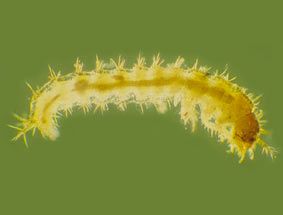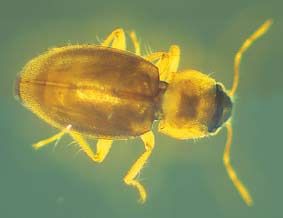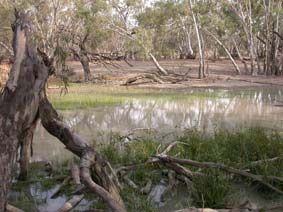Major Group: Insecta
Order: Coleoptera
Family: Hydraenidae |
Descriptive Features:
Adults
antennae 9-segmented with 5-segmented club
prothorax without notopleural sutures, ventral portion of the notum, (hypomeron) on each side joined directly to the sternum by notosternal suture and pleuron reduced and concealed
abdomen with more than 3 ventrites
ventrite 1 not divided by hind coxae
elytra exposing less than 2 complete abdominal tergites
size: 0.8 - 2.5mm
Larvae
maxillary palp 2- or 3-segmented
antennae 3-segmented; maxillary palps 3-segmented
labrum separated from head capsule by complete suture
mandibular mola present
basal portion of labium completely free or basally connate with maxillae
bases of frontal arms contiguous
epicranial stem present
tergum 9 with articulated urogomphi
legs present
size: up to 2.5mm |

|
Hydraenidae larva |
|
|

|
Hydraena ypsilon adult |
|
Taxonomic Checklist: Genera
Gymnanthelius 8 species
Gymnochthebius 33 species
Hydraena 85 species
Limnebius acupunctus Perkins
Octhebius queenslandicus Hansen
Tympanogaster 84 species*
* possibly only the subgenus Tympanogaster (sensu stricto) 38 species are semi-aquatic |
|
Distribution: Australia wide
Sensitivity Rating: SIGNAL grade 3
Functional Feeding Group: scrapers (adults), predators (larvae) |

|
Billabong Creek at Wanganella, NSW |
|
|
Ecology: Hydraenidae species are mostly aquatic, but some species are terrestrial throughout the life cycle.
Instream habitat: Hydraenid beetles live in a variety of riparian, littoral and aquatic habitats, including inland salt lakes. As a family, they are often abundant at the edges of gravely rivers and streams. Most Hydraena species also prefer shade with some leaf litter or aquatic plants. A few species appear to live only in ponds and at least one species, Hydraena hamifers, is found primarily in humicolous microhabitats. Meropathus species inhabit moss in the spray zone of cascades and waterfalls. Adults and larvae of Tympanogaster live in the vegetation on rocks in mountain streams where they are not always covered by water but are kept wet by splashes. Ochthebius species appear to live in algal crusts of mud and sand in marginal areas of flowing waters and standing fresh or saline waters.
Feeding ecology: Adults of Australian species are mainly herbivores feeding on algae. Larvae are thought to be scavengers. Northern hemisphere studies indicate that adults and larvae of some species may be detritivores
Habit: Adults hydraenid beetles crawl upside down just under the water surface with an air bubble on the ventral side of the abdomen. Hydraena beetles crawl on vegetation and merely float to the surface if they become dislodged.
Life history: In the northern hemisphere, hydraenid beetles lay eggs on wood and stones just beneath the waterline. Early instar larvae leave the water but live near to it.
|
| |
Information Sources: Watts 2002, Perkins 2004b, 2006, 2007a, 2007b, Lawrence & Britton 1991, Mathews 1982, Williams 1980, Gooderham & Tsyrlin 2002, Ribera & Vogler 2000
Key to Genera: Watts 2002 (adults, partial)
Key to Species: Perkins 2004a (Gymnanthelius adults)
Perkins 2005 (Gymnochthebius adults)
Perkins 2006 (Tympanogaster adults)
Perkins 2007a (Hydraena adults - monograph not key) |
|
|
|